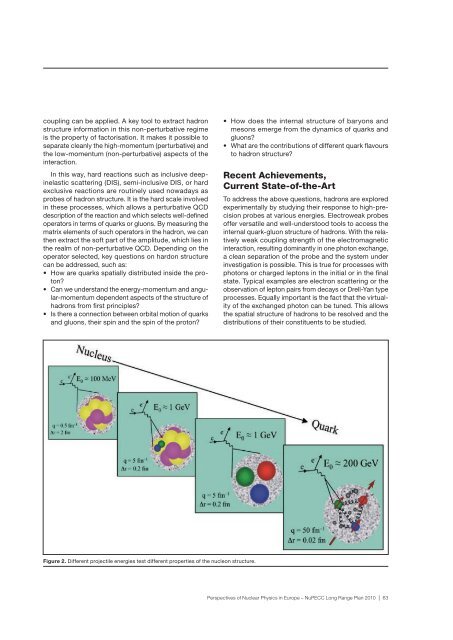Perspectives of Nuclear Physics in Europe - European Science ...
Perspectives of Nuclear Physics in Europe - European Science ...
Perspectives of Nuclear Physics in Europe - European Science ...
You also want an ePaper? Increase the reach of your titles
YUMPU automatically turns print PDFs into web optimized ePapers that Google loves.
coupl<strong>in</strong>g can be applied. A key tool to extract hadron<br />
structure <strong>in</strong>formation <strong>in</strong> this non-perturbative regime<br />
is the property <strong>of</strong> factorisation. It makes it possible to<br />
separate cleanly the high-momentum (perturbative) and<br />
the low-momentum (non-perturbative) aspects <strong>of</strong> the<br />
<strong>in</strong>teraction.<br />
In this way, hard reactions such as <strong>in</strong>clusive deep<strong>in</strong>elastic<br />
scatter<strong>in</strong>g (DIS), semi-<strong>in</strong>clusive DIS, or hard<br />
exclusive reactions are rout<strong>in</strong>ely used nowadays as<br />
probes <strong>of</strong> hadron structure. It is the hard scale <strong>in</strong>volved<br />
<strong>in</strong> these processes, which allows a perturbative QCD<br />
description <strong>of</strong> the reaction and which selects well-def<strong>in</strong>ed<br />
operators <strong>in</strong> terms <strong>of</strong> quarks or gluons. By measur<strong>in</strong>g the<br />
matrix elements <strong>of</strong> such operators <strong>in</strong> the hadron, we can<br />
then extract the s<strong>of</strong>t part <strong>of</strong> the amplitude, which lies <strong>in</strong><br />
the realm <strong>of</strong> non-perturbative QCD. Depend<strong>in</strong>g on the<br />
operator selected, key questions on hardon structure<br />
can be addressed, such as:<br />
• How are quarks spatially distributed <strong>in</strong>side the proton<br />
• Can we understand the energy-momentum and angular-momentum<br />
dependent aspects <strong>of</strong> the structure <strong>of</strong><br />
hadrons from first pr<strong>in</strong>ciples<br />
• Is there a connection between orbital motion <strong>of</strong> quarks<br />
and gluons, their sp<strong>in</strong> and the sp<strong>in</strong> <strong>of</strong> the proton<br />
• How does the <strong>in</strong>ternal structure <strong>of</strong> baryons and<br />
mesons emerge from the dynamics <strong>of</strong> quarks and<br />
gluons<br />
• What are the contributions <strong>of</strong> different quark flavours<br />
to hadron structure<br />
Recent Achievements,<br />
Current State-<strong>of</strong>-the-Art<br />
To address the above questions, hadrons are explored<br />
experimentally by study<strong>in</strong>g their response to high-precision<br />
probes at various energies. Electroweak probes<br />
<strong>of</strong>fer versatile and well-understood tools to access the<br />
<strong>in</strong>ternal quark-gluon structure <strong>of</strong> hadrons. With the relatively<br />
weak coupl<strong>in</strong>g strength <strong>of</strong> the electromagnetic<br />
<strong>in</strong>ter action, result<strong>in</strong>g dom<strong>in</strong>antly <strong>in</strong> one photon exchange,<br />
a clean separation <strong>of</strong> the probe and the system under<br />
<strong>in</strong>vestigation is possible. This is true for processes with<br />
photons or charged leptons <strong>in</strong> the <strong>in</strong>itial or <strong>in</strong> the f<strong>in</strong>al<br />
state. Typical examples are electron scatter<strong>in</strong>g or the<br />
observation <strong>of</strong> lepton pairs from decays or Drell-Yan type<br />
processes. Equally important is the fact that the virtuality<br />
<strong>of</strong> the exchanged photon can be tuned. This allows<br />
the spatial structure <strong>of</strong> hadrons to be resolved and the<br />
distributions <strong>of</strong> their constituents to be studied.<br />
Figure 2. Different projectile energies test different properties <strong>of</strong> the nucleon structure.<br />
<strong>Perspectives</strong> <strong>of</strong> <strong>Nuclear</strong> <strong>Physics</strong> <strong>in</strong> <strong>Europe</strong> – NuPECC Long Range Plan 2010 | 63
















